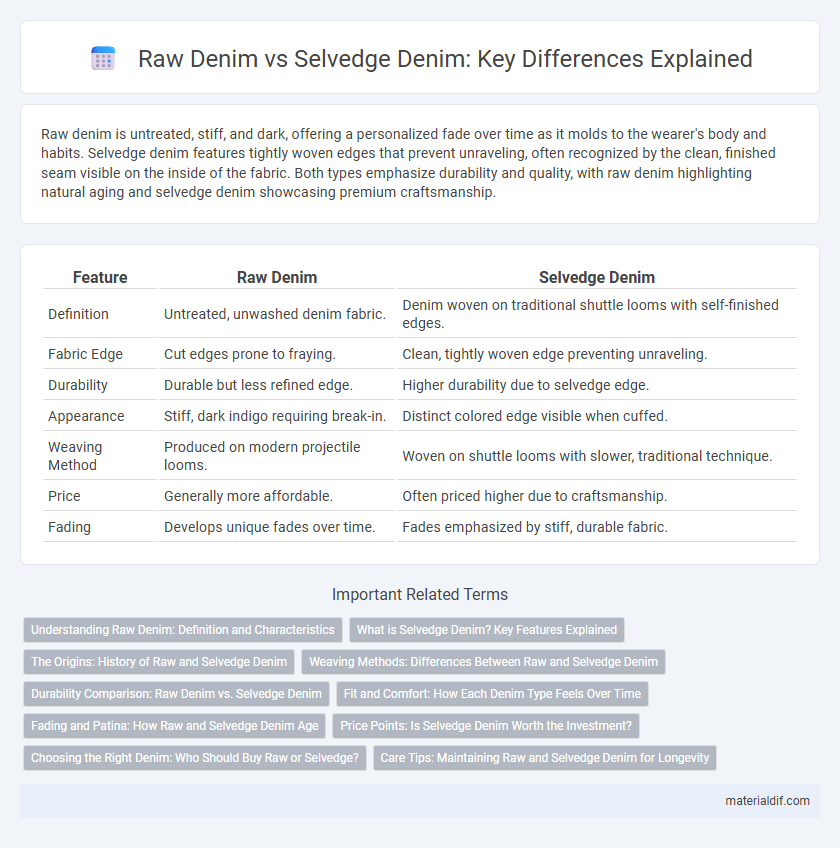Raw denim is untreated, stiff, and dark, offering a personalized fade over time as it molds to the wearer's body and habits. Selvedge denim features tightly woven edges that prevent unraveling, often recognized by the clean, finished seam visible on the inside of the fabric. Both types emphasize durability and quality, with raw denim highlighting natural aging and selvedge denim showcasing premium craftsmanship.
Table of Comparison
| Feature | Raw Denim | Selvedge Denim |
|---|---|---|
| Definition | Untreated, unwashed denim fabric. | Denim woven on traditional shuttle looms with self-finished edges. |
| Fabric Edge | Cut edges prone to fraying. | Clean, tightly woven edge preventing unraveling. |
| Durability | Durable but less refined edge. | Higher durability due to selvedge edge. |
| Appearance | Stiff, dark indigo requiring break-in. | Distinct colored edge visible when cuffed. |
| Weaving Method | Produced on modern projectile looms. | Woven on shuttle looms with slower, traditional technique. |
| Price | Generally more affordable. | Often priced higher due to craftsmanship. |
| Fading | Develops unique fades over time. | Fades emphasized by stiff, durable fabric. |
Understanding Raw Denim: Definition and Characteristics
Raw denim refers to untreated, unwashed denim fabric that retains its original stiffness and deep indigo color due to the absence of chemical processing. This type of denim is known for developing unique fades and creases that reflect the wearer's lifestyle over time. Unlike selvedge denim, which is defined by its tightly woven edge, raw denim emphasizes authenticity and customization through natural aging processes.
What is Selvedge Denim? Key Features Explained
Selvedge denim is a high-quality fabric distinguished by its tightly woven edges that prevent unraveling, produced on traditional shuttle looms. Key features include a clean edge finished with a colored thread, often visible when jeans are cuffed, and superior durability due to the dense weaving technique. This denim offers a unique texture and fade pattern, making it favored by enthusiasts seeking longevity and authenticity in their jeans.
The Origins: History of Raw and Selvedge Denim
Raw denim originated in the early 20th century as untreated, stiff fabric made from shuttle looms, preserving the natural indigo dye and durability favored by miners and laborers. Selvedge denim, characterized by its tightly woven, self-finished edges, emerged simultaneously in the same era, produced on narrow shuttle looms that prevent fraying and enhance fabric strength. Both denim types share a heritage rooted in American workwear, evolving from practical garments to iconic fashion staples prized for their unique aging and craftsmanship.
Weaving Methods: Differences Between Raw and Selvedge Denim
Raw denim refers to untreated fabric that retains its natural stiffness and deep indigo dye, while selvedge denim is defined by its self-finished edges created through traditional shuttle loom weaving. The weaving method in selvedge denim produces a tightly woven, clean edge that prevents unraveling, distinguishing it from raw denim often woven on modern projectile looms with open, unfinished edges. This key difference in loom type and edge finishing not only impacts durability but also affects the aesthetic and authenticity valued by denim enthusiasts.
Durability Comparison: Raw Denim vs. Selvedge Denim
Raw denim and selvedge denim differ significantly in durability, with selvedge denim typically offering enhanced strength due to its tightly woven, self-finished edges that resist fraying. The loom-types used for selvedge denim, such as shuttle looms, produce a denser fabric that withstands wear and tear better than the open-edge finish of raw denim. Over time, selvedge denim's superior construction provides longer-lasting resilience, maintaining structural integrity through repeated washes and abrasion.
Fit and Comfort: How Each Denim Type Feels Over Time
Raw denim starts stiff and rigid but gradually softens and molds to the wearer's body, resulting in a personalized fit and increased comfort over time. Selvedge denim, distinguished by its tightly woven edge, maintains structural integrity while becoming smoother with wear, offering a consistent fit that resists fraying and distortion. Both types evolve uniquely, with raw denim emphasizing customization through natural wear, and selvedge denim balancing durability and comfort.
Fading and Patina: How Raw and Selvedge Denim Age
Raw denim ages uniquely through natural fading, developing personalized patinas influenced by wear patterns and body movements, resulting in distinct, rich color contrasts. Selvedge denim, characterized by its tightly woven edge and higher fabric quality, often produces sharper, more defined fades that enhance the durability and aesthetic appeal over time. The slow aging process in both raw and selvedge denim highlights the craftsmanship, creating highly coveted, one-of-a-kind garments.
Price Points: Is Selvedge Denim Worth the Investment?
Selvedge denim typically commands a higher price point due to its traditional shuttle loom production, which yields a densely woven, durable fabric with clean, finished edges. Raw denim, while generally more affordable, offers a unique opportunity for personalized wear patterns through gradual fading but may lack the premium craftsmanship associated with selvedge. Investing in selvedge denim is justified for enthusiasts seeking long-lasting quality and a distinctive aesthetic, whereas raw denim suits those prioritizing budget and customization potential.
Choosing the Right Denim: Who Should Buy Raw or Selvedge?
Raw denim offers a stiff, unwashed fabric ideal for enthusiasts who value personalized fading and long-term durability, making it perfect for those seeking a unique, evolving look. Selvedge denim, characterized by its tightly woven edges and premium craftsmanship, suits buyers prioritizing high-quality construction and a classic aesthetic with a clean finish. Both options cater to different preferences, with raw denim favoring customization and selvedge denim emphasizing heritage and durability.
Care Tips: Maintaining Raw and Selvedge Denim for Longevity
Raw denim requires minimal washing to preserve its unique fading patterns, ideally washed inside out with cold water and mild detergent. Selvedge denim benefits from spot cleaning and air drying to maintain fabric integrity and the distinctive self-finished edges. Both types thrive with gentle handling, avoiding frequent washing and using denim-specific care products to extend their lifespan.
Raw denim vs Selvedge denim Infographic

 materialdif.com
materialdif.com